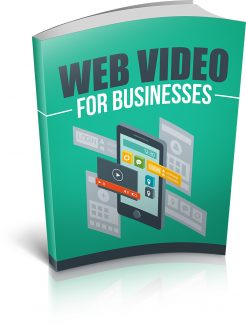 License Type: Master Resell Rights
License Type: Master Resell Rights  File Type: ZIP
File Type: ZIP
 SKU: 62391
SKU: 62391  Shipping: Online Download
Shipping: Online Download
Sample Content Preview
Your Recording Setup
Depending on what your audio-visual sales concept is, you may or may not use the information in this chapter. But many of the best audio-visual concepts do involve video recording, even if it's just a quick product demonstration or a testimonial clip tucked into the midsection of your sales page. So even if you don't think you'll use this information with your current page, it's not a bad idea to quickly browse this information anyway. If nothing else, you may get a few good ideas for a more elaborate direct sales site in the future.
Cameras: Dos and Don'ts
In order to really translate your idea into a video presentation that you can work with, you'll need to make sure your camera is equipped with a few vital functions, and you'll need to make sure and avoid a few common errors for first-time camera buyers.
Above all: make sure that your camera has a jack for an external microphone. We talked about the reasons for this in the last chapter--you need to avoid capturing humming feedback from the camera itself, you need to make sure you can record strong directional audio--but it's important enough to repeat here. Having an external mic jack frees you from dependence on whatever equipment you start with and lets you record audio in a variety of situations. It also--and maybe more importantly--ensures that you don't have to record and synchronize your audio separately, in the editing room. Anyone with painful experience editing video and audio together will appreciate the ability to avoid this extra step.
You can make sure that your camera is picking up both video and audio in a single chunk of data, you can avoid extra time and technical problems later, and you can ensure that your audio is of the highest quality possible. An external microphone jack: do not try to do without it!
A tripod seems as if it'd be equally as important, but in practice you can often get away without using one. Any indoor shooting you do will probably give you some opportunity to place your camera in a secure location, even if sometime it takes a little bit of imagination to do so. Outdoor shooting will invariably be more complicated and it's worth investing in a tripod if your sales concept requires a lot of outdoor shooting or testimonials that you plan to film on site. (Whatever you choose to do, make sure that you don't just fall back on holding the camcorder in your hands: it's shaky and irritating to watch and it just looks unprofessional.)
How your camcorder records film is another important issue. The choice of which recording method you want to use is going to depend on what software you plan to use to edit your footage into something you can put on the web. Ideally, you'll want to start with the highest resolution, frame rate, and picture quality that you possibly can--streaming or downloading video on the web always requires some loss of quality, and the more high-resolution your raw footage is, the better you'll do after compression.
There are plenty of different options for actually saving your video data. But in reality, there are two workable options: mini-DV tapes, or an on-board hard drive and a direct USB connection. (Don't even think about trying to use non-DV formats for filming audio-visual material: you'll have to invest in expensive "capture cards", you'll suffer a major loss of video quality, and you'll simply add endless amounts of hassle to your development cycle with no clear reward.)
Mini-DV tapes have the distinct drawback of being expensive, unless of course you keep erasing and reusing old tapes. Doing that, though, eliminates one of the best advantages of the mini-DV tape format: archiving your footage. One man's trash is another man's treasure, and if you can't use that nice exterior footage you filmed for this project, you can certainly use it for a future audio-visual project without spending extra time on filming things twice. You also have a permanent backup of any critical footage (an interview with a difficult-to-contact but well-known actor who uses your product, maybe), in case the worst happens, you lose your edited movie files, and you have to start over from scratch. Over time, you'll likely find that the added peace of mind and convenience of having your footage backed up far outweighs the hassle and cost of buying tapes.
A direct USB connection is the other viable option. You lose the ability to store all of your footage, since you'd have to store it on a computer rather than on tapes, and your footage will quickly eat up too much of your hard drive space if you're filming at high quality. But you do save on the cost of tapes, and you do have the ability to quickly grab the day's footage from your camera and shoot it directly into your editing software without any hassle. Mini-DV tapes sometimes require complicated interfaces in order to get your footage into your computer, and transferring your footage from peripheral to peripheral can lead in a worst-case scenario to losing significant amounts of quality. If you don't want to mess around with this problem and you don't think you'll need to retain much of the footage you've been shooting for future projects, just make sure your camcorder has a USB connection (honestly, you'd have to work pretty hard to find a new camcorder that doesn't.)
The only other thing to remember when choosing a camcorder is, of course, to test it out before you buy it. Make sure you like the control options--zooms, resolutions, effects. Make sure you like how the camera captures and displays light: if everything looks overexposed and difficult to make out just in your test footage, you're not going to want to wrestle with the thing for your entire project. And again: make sure that the camera's resolution and file format works with your editing software, and that it's reasonable as far as how much memory it takes up. There's no point in getting perfect footage if doing so will inevitably crash your editing software.
The Face Of Your Product
No one expects you to hire John Gielgud to be in your software commercial. That said, though, you don't want to go as cheaply as possible where actors are concerned. It just takes one halting delivery, problematic accent, or other flaw to turn your site into the laughing stock of the Internet. Either use people in-house who you can rely on to represent your product, or consider investing a little bit of time in finding an actor or actress.
This isn't as expensive as it sounds, especially if you're near a major city. Any college town or large urban center will have a population of actors, many with impressive technical training, but few actual production credits as yet. If you find a sufficiently young and resume-poor actor or actress through online creative services sites (Craigslist being a classic option) or through other channels, you can often convince them to do a day or two of shooting with you for nothing but the experience of being on camera and a good letter of recommendation to future potential employers. There's plenty of talent out there waiting to be discovered, and there's no reason to let it lie fallow when you could put it to work for you or your project for almost nothing.
If you live in a rural area or just don't have a good local talent pool, you'll have to use someone in house. There are endless books written about the difficulty of casting, but as a general rule, pick someone with a pleasant, friendly face and pick someone who's easy to understand. It'll make your content seem more professional and it'll provide a more positive emotional branding for your product.
And if you simply don't have other options, don't overlook the power of testimonials. Get some friends of yours who've used your product and who like it to let you record them talking about how much they enjoy the product. In this case, their lack of technical acting training is an asset: it'll give your production an air of authenticity and make the testimonials that much more convincing. Plus working with friends is an all-time good deal, since they'll most likely be excited enough by the prospect of appearing in your "commercials" that they'll work for friendship, or for free.








